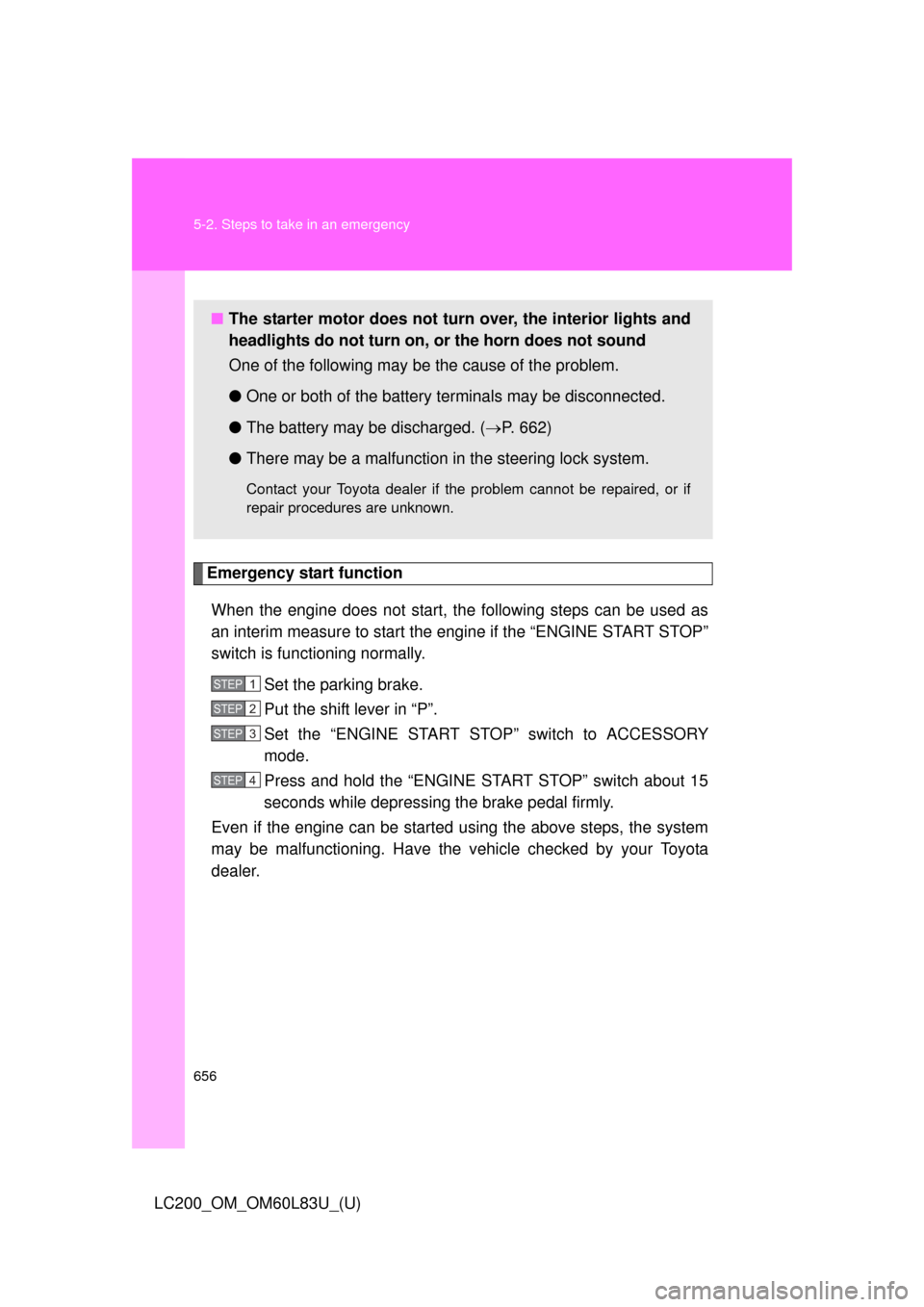Page 515 of 728
Maintenance and care4
515
LC200_OM_OM60L83U_(U)
4-1. Maintenance and careCleaning and protecting the vehicle exterior ......... 516
Cleaning and protecting the vehicle interior .......... 519
4-2. Maintenance Maintenance requirements .................. 522
General maintenance....... 525
Emission inspection and maintenance (I/M)
programs........................ 528
4-3. Do-it-yourself maintenance Do-it-yourself service precautions .................... 529
Hood ................................ 532
Engine compartment ........ 533
Tires ................................. 548
Tire inflation pressure ...... 557
Wheels ............................. 561
Air conditioning filter......... 564
Electronic key battery....... 567
Checking and replacing fuses ............... 570
Headlight aim ................... 584
Light bulbs........................ 586
Page 543 of 728
543
4-3. Do-it-yourself maintenance
4
Maintenance and care
LC200_OM_OM60L83U_(U)
Power steering fluid
■ Fluid level
The fluid level should be within the appropriate range.
Full (when hot)
Add fluid (when hot)
Full (when cold)
Add fluid (when cold)
Hot: Vehicle has been driven around 50 mph (80 km/h) for 20 min- utes, or slightly longer in frig id temperatures. (Fluid tempera-
ture, 140°F - 175°F [60°C - 80°C]).
Cold: Engine has not been run for about five hours. (Room tem- perature, 50°F - 85°F [10°C - 30°C]).
■ Checking the fluid level
Make sure to check the fluid type and prepare the necessary items.
Clean all dirt off the reservoir.
Remove the cap by turning it counterclockwise.
Wipe the dipstick clean.
Reinstall and remove the reservoir cap again.
Check the fluid level.
1
23
4
ITY43C070
Fluid typeAutomatic transmission fluid DEXRON® II or III
ItemsRag or paper, Clean funnel (only for adding fluid)
STEP1
STEP2
STEP3
STEP4
STEP5
Page 586 of 728
586
4-3. Do-it-yourself maintenance
LC200_OM_OM60L83U_(U)
Light bulbs
You may replace the following bulbs by yourself. The difficulty level
of replacement varies depending on the bulb. If necessary bulb
replacement seems difficult to perfor m, contact your Toyota dealer.
For more information about replacing other light bulbs, contact your
Toyota dealer.
■ Prepare a replacement light bulb
Check the wattage of the light bulb being replaced. ( P. 683)
■ Remove the engine compartment cover
P. 534
■ Front bulb locations
Front side marker light
Fog light
Headlight high beam
and daytime
running light
Front turn signal light
Page 619 of 728

5
When trouble arises
619
5-2. Steps to take in an emergency
LC200_OM_OM60L83U_(U)
■
If the malfunction indicator lamp comes on while driving
First check the following:
● Is the fuel empty?
If it is, fill the fuel tank immediately.
● Is the fuel tank cap loose?
If it is, tighten it securely.
The malfunction indicator lamp will go off after taking several driving trips. If
the malfunction indicator lamp does not go off even after several trips, con-
tact your Toyota dealer as soon as possible.
■ If the low speed four-wheel drive in dicator light or the center differen-
tial lock indicator light blinks
Take the specified steps. ( P. 247)
If the brake system warning light or the malfunction indicator light also
comes on, or the low speed four-wheel drive indicator light or the center dif-
ferential lock indicator light continues to blink after taking the specified steps,
there may be a malfunction in the engine, the brake system or the four-
wheel drive system. In this case, you may not be able to transfer between
“H4” and “L4” modes, and the center differential lock may not be able to be
locked or unlocked. Have the vehicle inspected by your Toyota dealer imme-
diately.
■ Front passenger detection sensor and passenger seat belt reminder
● If luggage is placed on the front passenger seat, the front passenger
detection sensor may cause the warning light to flash, even if a passen-
ger is not sitting in the seat.
● If a cushion is placed on the seat, the sensor may not detect a passen-
ger, and the warning light may not operate properly.
Page 620 of 728

620 5-2. Steps to take in an emergency
LC200_OM_OM60L83U_(U)
■SRS warning light
This warning light system monitors the following:
●The airbag sensor assembly
● Front impact sensors
● Side impact sensors (rear)
● Side impact sensors (front door)
● Safing sensor (rear)
● The driver’s seat belt buckle switch
● The driver’s seat position sensor
● Front passenger’s seat belt buckle switch
● The airbags
● The interconnecting wiring and power sources
● The front passenger occupant classification system
● “AIR BAG ON” and “AIR BA G OFF” indicator lights
● The seat belt pretensioners
● The “RSCA OFF” indicator light
■ Changing the engine oil
Make sure to reset oil change system
■
When the tire pressure warning light comes on
Check the tire inflation pressure and adjust to the appropriate level.
Pushing the tire pressure warning reset switch does not turn off the tire
pressure warning light.
■The tire pressure warning light ma y turn on due to natural causes
The tire pressure warning light may turn on due to natural causes such
as natural air leaks or tire inflation pressure changes caused by temper-
ature. In this case, adjusting the ti re inflation pressure will turn off the
warning light (after a few minutes).
Page 622 of 728

622 5-2. Steps to take in an emergency
LC200_OM_OM60L83U_(U)
■If the tire pressure warning light frequently comes on after blinking
for 1 minute
If the tire pressure warning light frequently comes on after blinking for 1
minute when the “ENGINE START STOP ” switch is turned to IGNITION
ON mode, have it checked by Toyota dealer.
CAUTION
■If the tire pressure warning light comes on
Be sure to observe the following precautions. Failure to do so could
cause loss of vehicle control and re sult in death or serious injury.
●Stop your vehicle in a safe place as soon as possible. Adjust the tire
inflation pressure immediately.
●If the tire pressure warning light comes on even after tire inflation pres-
sure adjustment, it is pr obable that you have a flat tire. Check the tires.
If the tire is flat, change to the spare tire and have the flat tire repaired
by the nearest Toyota dealer.
●Avoid abrupt maneuvering and braking. If the vehicle tires deteriorate,
you could lose control of the steering wheel or the brakes.
■If a blowout or sudden air leakage should occur
The tire pressure warning syste m may not activate immediately.
Page 634 of 728
634 5-2. Steps to take in an emergency
LC200_OM_OM60L83U_(U)
Have the malfunction repaired immediately.After taking the specified steps to correct the suspected problem,
check that the warning message and light go off.
Interior buzzerExterior buzzerWarning messageDetailsCorrection procedure
Once3 times
(Flashes) The electronic key
was carried out-
side the vehicle
and a door other
than the driver’s
door was opened
and closed while
the “ENGINE
START STOP”
switch was in a
mode other than
off.
Bring the
electronic
key back
into the
vehicle.
The driver’s door
was opened and
closed while the
electronic key was
not in the vehicle,
the shift lever was
in “P” and the
“ENGINE START
STOP” switch was
not turned off. Turn the
“ENGINE
START
STOP”
switch off
or bring the
electronic
key back
into the
vehicle.
Page 656 of 728

656 5-2. Steps to take in an emergency
LC200_OM_OM60L83U_(U)
Emergency start functionWhen the engine does not start, the following steps can be used as
an interim measure to start the engine if the “ENGINE START STOP”
switch is functioning normally. Set the parking brake.
Put the shift lever in “P”.
Set the “ENGINE START ST OP” switch to ACCESSORY
mode.
Press and hold the “ENGINE START STOP” switch about 15
seconds while depressing the brake pedal firmly.
Even if the engine can be start ed using the above steps, the system
may be malfunctioning. Have the vehicle checked by your Toyota
dealer.
■ The starter motor does not turn over, the interior lights and
headlights do not turn on, or the horn does not sound
One of the following may be the cause of the problem.
● One or both of the battery terminals may be disconnected.
● The battery may be discharged. ( P. 662)
● There may be a malfunction in the steering lock system.
Contact your Toyota dealer if the problem cannot be repaired, or if
repair procedures are unknown.
STEP1
STEP2
STEP3
STEP4